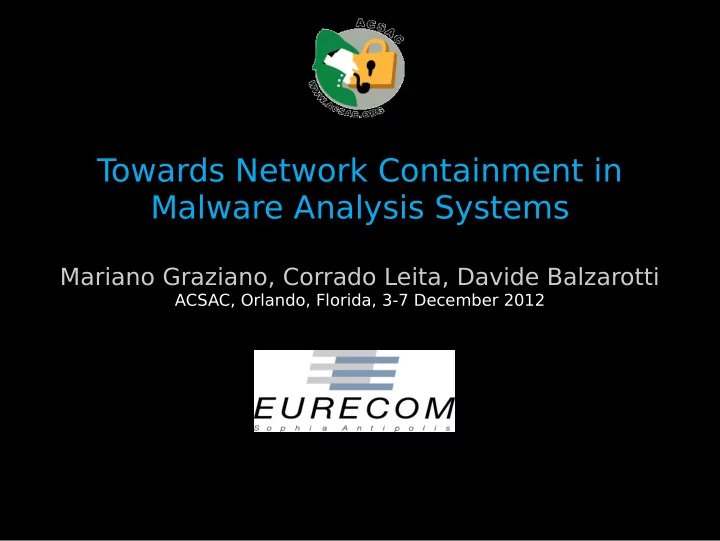

T owards Network Containment in Malware Analysis Systems Mariano Graziano, Corrado Leita, Davide Balzarotti ACSAC, Orlando, Florida, 3-7 December 2012
Malware Analysis Scenario ● Analysis based on Sandboxes (API Hooking, Emulation) ● Complex and distributed Security Companies Infrastructure ● Malware behavior often depends on external factors (C&C servers) ● Sophisticated attacks involve multiple stages
Malware Execution Stages DNS name resolution DNS Download additional WEB components, check Internet SERVER connectivity MALWARE Receive commands, C&C exfiltrate information SERVER Extend infected population PCs
Repeatability & Containment DNS name resolution DNS Web Server Unreachable, WEB Impossible to download the SERVER components MALWARE Receive commands, C&C exfiltrate information SERVER Impossible to harm other CONTAINMENT machines PCs
Goal ● Goal: – Model/Replay the network traffic for malware containment and experiment repeatability ● Motivation: – Malware behavior often depends on the network context – Experiments are not repeatable over time – Sandbox containment of polymorphic variations
Malware Containment ● Only possible in case of: Polymorphic variations Re-execution of the same sample ● Full containment → Repeatable execution ● Current containment solutions: APPROACH CONTAINMENT QUALITY Full Internet Access x ~ Filter/Redirect specific ports ~ ~ Common service emulation v ~ Full Isolation v x
Roadmap ● Introduction ● Protocol Inference ● System Overview ● Evaluation
ScriptGen 1 ● Existing suite of protocol learning techniques developed for high interaction honeypots ● It aims at rebuilding portions of a protocol finite state machine (FSM) through the observation of samples of network interaction between a client and a server implementing such protocol ● No assumption is made on the protocol structure, and no a priori knowledge is assumed on the protocol semantics 1 Leita Corrado, Mermoud Ken, Dacier Marc - “ScriptGen: an automated script generation tool for honeyd” - ACSA 2005, 21st Annual Computer Security Applications Conference, December 5-9, 2005, Tucson, USA
Finite State Machine ● It is a tree: The vertices contain the server’s answer The edges contain the client’s request SMTP Finite State Machine
Roadmap ● Introduction ● Protocol Inference ● System Overview ● Evaluation
System Overview ● Traffic Collection ● By running the sample in a sandbox or by using past analyses ● Endpoint Analysis ● Cleaning and normalization process ● Traffic Modeling ● Model generation (two ways: incremental learning or offline) ● Traffic Containment ● Two modes (Full or partial containment)
Traffic Model Creation TRAFFIC NETWORK ENDPOINT ANALYSIS MODELING TRACES SANDBOX CLUSTERING NORMALIZATION SCRIPTGEN
Mozzie – Full Containment SANDBOX TRAFFIC CONTAINMENT FSM Player
Mozzie – Partial Containment TRAFFIC CONTAINMENT FSM Player REMOTE SERVER SANDBOX Refinement
Partial containment FULL CONTAINMENT SETUP PHASE PROXY PHASE
Roadmap ● Introduction ● Protocol Inference ● System Overview ● Evaluation
Experiments ● Goals – Find minimum number of network traces to generate a FSM to fully contain the network traffic – Learning optimal parameters for commonly used protocols (HTTP, IRC, DNS, SMTP) + custom protocols ● Two groups of experiments – Offline – Incremental learning
Offline Experiments Sample Category Containmnet Normalization Traces W32/Virut IRC Botnet FULL NO 15 PHP/PBot.AN IRC Botnet FULL NO 12 W32/Koobface.EXT HTTP Botnet 72% YES 9 W32/Agent.VCRE Dropper FULL NO 23 W32/Agent.XIMX Dropper FULL YES 10
Incremental Learning Experiments Sample Category Runs Containment Normalization W32/Banload.BFHV Dropper 23 FULL NO W32/Downloader Dropper 25 FULL NO W32/Troj_generic.AUULE Ransomware 4 FULL NO W32/Obfuscated.X!genr Backdoor 6 FULL NO SCKeylog.ANMB Keylogger 14 FULL YES
Results ● Tested samples: 2 IRC botnets, 1 HTTP botnet, 4 droppers, 1 ransomware, 1 backdoor and 1 keylogger ● Required network traces ranging from 4 to 25 (AVG 14) ● DNS lower bound (6 traces) ● On AVG the number of traces is reasonable (Polymorphism, packing techniques)
Limitations ● Protocol agnostic approach ✔ Find a good trade-off ● Analysis of encrypted protocols is impossible ✔ API level solution ✔ MITM solution ● Malware with different behaviors (Domain flux) ✔ Improve the training set ✔ Protocol-aware heuristics
Use Cases ● Repeat the analysis after weeks/months ● Analysis of similar variations (polymorphic) of the same sample ● Provide network containment for privacy/ethical issues ● Analysis of sophisticated attacks (Stuxnet/SCADA systems)
The end THANK YOU graziano@eurecom.fr
Recommend
More recommend